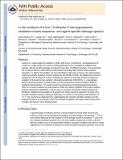In Situ Analysis of 8-Oxo-7,8-dihydro-2′-deoxyguanosine Oxidation Reveals Sequence- and Agent-Specific Damage Spectra
Author(s)
Lim, Kok Seong; Cui, Liang; Taghizadeh, Koli; Wishnok, John S.; Chan, Wan Simon; DeMott, Michael S.; Babu, I. Ramesh; Dedon, Peter C.; Tannenbaum, Steven Robert; ... Show more Show less
DownloadDedon_In situ analysis.pdf (1.274Mb)
PUBLISHER_POLICY
Publisher Policy
Article is made available in accordance with the publisher's policy and may be subject to US copyright law. Please refer to the publisher's site for terms of use.
Terms of use
Metadata
Show full item recordAbstract
Guanine is a major target for oxidation in DNA, with 8-oxo-7,8-dihydro-2′-deoxyguanosine (8-oxodG) as a major product. 8-oxodG is itself significantly more susceptible to oxidation than guanine, with the resulting damage consisting of more than 10 different products. This complexity has hampered efforts to understand the determinants of biologically relevant DNA oxidation chemistry. To address this problem, we have developed a high mass accuracy mass spectrometric method to quantify oxidation products arising site specifically in DNA. We applied this method to quantify the role of sequence context in defining the spectrum of damage products arising from oxidation of 8-oxodG by two oxidants: nitrosoperoxycarbonate (ONOOCO[subscript 2]–), a macrophage-derived chemical mediator of inflammation, and the classical one-electron oxidant, riboflavin-mediated photooxidation. The results reveal the predominance of dehydroguanidinohydantoin (DGh) in 8-oxodG oxidation by both oxidants. While the relative quantities of 8-oxodG oxidation products arising from ONOOCO[subscript 2]– did not vary as a function of sequence context, products of riboflavin-mediated photooxidation of 8-oxodG were highly sequence dependent. Several of the 8-oxodG oxidation products underwent hydrolytic conversion to new products with half-lives of 2–7 h. The results have implications for understanding the chemistry of DNA oxidation and the biological response to the damage, with DNA damage recognition and repair systems faced with a complex and dynamic set of damage targets.
Date issued
2012-10Department
Massachusetts Institute of Technology. Center for Environmental Health Sciences; Massachusetts Institute of Technology. Department of Biological EngineeringJournal
Journal of the American Chemical Society
Publisher
American Chemical Society (ACS)
Citation
Lim, Kok Seong, Liang Cui, Koli Taghizadeh, John S. Wishnok, Wan Chan, Michael S. DeMott, I. Ramesh Babu, Steven R. Tannenbaum, and Peter C. Dedon. “In Situ Analysis of 8-Oxo-7,8-Dihydro-2′-Deoxyguanosine Oxidation Reveals Sequence- and Agent-Specific Damage Spectra.” Journal of the American Chemical Society 134, no. 43 (October 31, 2012): 18053–18064.
Version: Author's final manuscript
ISSN
0002-7863
1520-5126